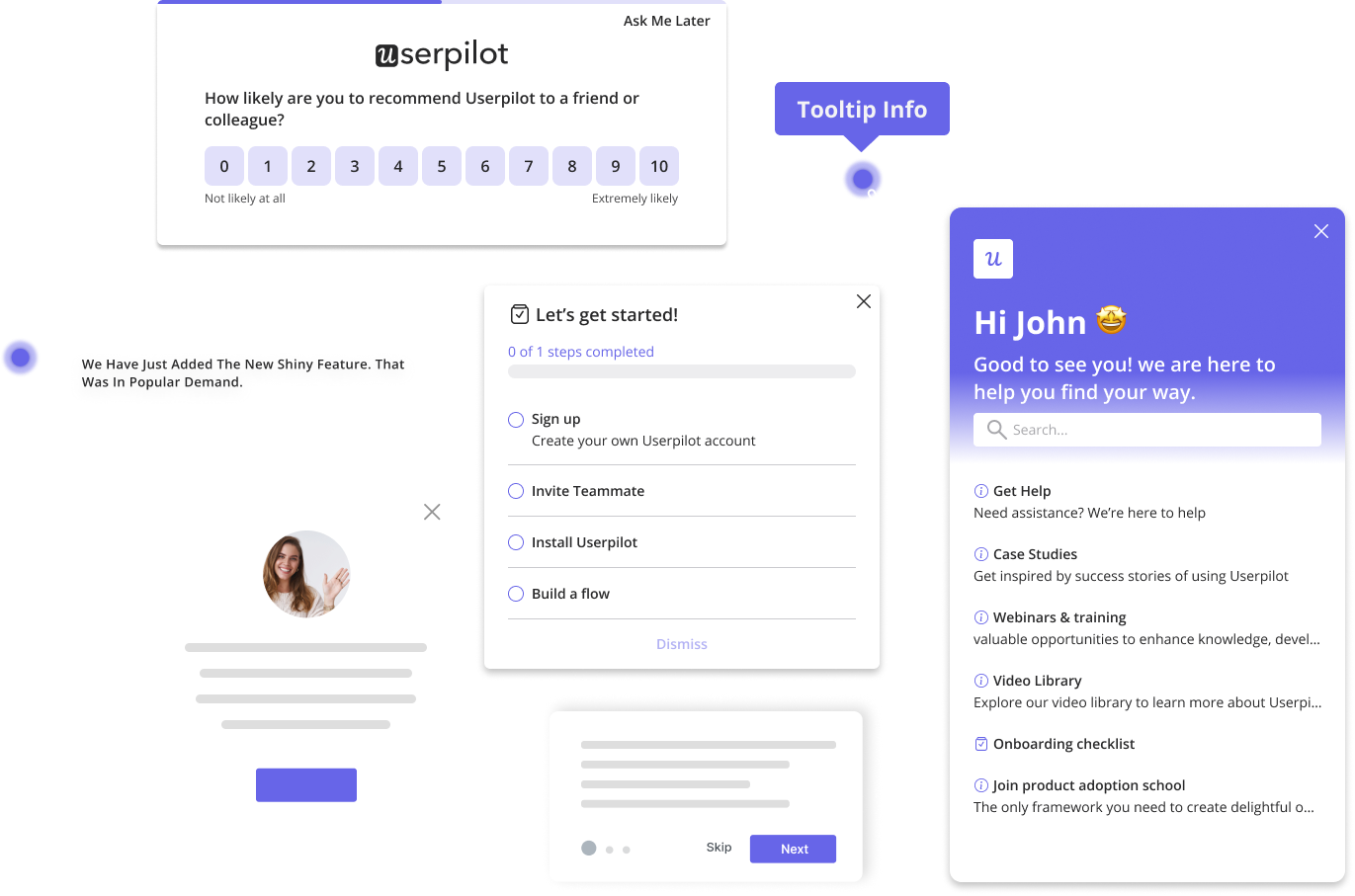
User experience includes every interaction someone has with your product: how quickly they find what they need, whether the interface feels intuitive, and if tasks flow naturally without friction.
For UX designers and product teams, the goal is to create exceptional user experiences. That means obsessing over small details like button placement, input field count, and eliminating unnecessary elements. But to get buy-in for UX improvements, good design is not enough: you need to provide stakeholders and executives with data.
UX statistics help you show design decisions as business impact metrics that executives care about. In this guide, I’ll share the statistics that connect user experience improvements to concrete outcomes: reduced churn, increased conversion rates, measurable revenue growth, and competitive advantage.
What’s your primary goal for using UX statistics?
How are you currently gathering user feedback?
Stop guessing. See the *why* behind your UX statistics.
The biggest gains don’t come from just *what* users do, but *why*
they do it. Userpilot connects quantitative analytics with
qualitative feedback so you can stop guessing and start improving.
Try Userpilot Now
See Why 1,000+ Teams Choose Userpilot
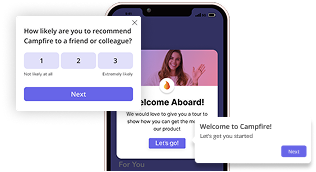
The core UX statistics: Framing user experience as a revenue driver
A great user experience isn’t just about making things “pretty.” It’s about building a sustainable, profitable business. I use the following statistics to present a powerful “carrot and stick” narrative that directly answers the ROI question, showcasing both the immense potential of great UX and the devastating cost of poor UX.
There’s a common objection that these industry-wide numbers from sources like Forrester or PwC can be too broad for specific projects. So, instead of simply relying on data to make a point, I use the stats as evidence that a better user experience directly correlates with better business outcomes.
The four-step process introduced later shows how to generate your own company-specific data to prove this principle in your context. So, think of industry benchmarks as your starting point and begin conducting user research within your own product to identify friction points unique to your users.
ROI of good UX statistics
When you invest in your users, they invest back in you with their time, loyalty, and money. I use these key UX statistics to frame user experience as one of the most powerful methods for revenue generation.
- Every dollar invested in UX design returns $100, representing a 9,900% ROI (Forrester)
- A well-designed user interface raises conversion rates by 200%, while a superior user experience increases conversion rates by 400%. (Forrester)
- Design-led companies outperformed the S&P index by 228% over 10 years, according to the Design Value Index. (Fortune)
- Companies prioritizing exceptional UX see 1.5x faster revenue growth than their competitors. (Wearetenet)
- PwC found that 86% of buyers will pay more for a great customer experience. In a crowded market, UX is the key differentiator that allows you to compete on value and customer loyalty, not just on price. (PwC)
- Staples experienced a 500% increase in online revenue following a UX focused site redesign. (Baymard)
- 80% of consumers believe the customer experience a company provides is as important as its products and services. (Salesforce)
- 77% of brands believe customer experience is a key competitive differentiator. (Maze)
- A 5% boost in customer retention can grow profits by 25-95%, and strong retention strategies drive this improvement. (Bain)
The statistics on the high cost of bad UX
If the promise of growth isn’t compelling enough, the threat of loss often is. A bad user experience actively pushes customers away, tarnishes your brand, and directly impacts your bottom line. These user experience statistics highlight the real, quantifiable dangers of neglecting UX.
- After just one bad experience, 32% of customers will stop doing business with a brand they once loved. (PwC)
- 88% of online consumers are less likely to return to a site after a poor user experience. (Toptal)
- 96% of unsatisfied customers who don’t complain simply leave. (Forbes)
- For every customer who complains, 26 remain silent. The vast majority of unhappy users don’t open a support ticket and instead just leave. Relying solely on tickets to gauge user sentiment can raise customer support costs, as you’d need more tickets for data. (Understanding Customers by Ruby Newell-Legner)
- Developers spend 50% of their time on avoidable rework, such as fixing bugs that early user feedback would have prevented. (Amazon AWS)
- Fixing an error after development is 100 times more expensive than it would have been to fix it during the design and prototyping stages. (Dr. Susan Weinschenk, 100 Things Every Designer Needs to Know About People)
- Poor UX costs U.S. businesses an estimated $1.4 trillion annually in lost business. (Amazon Web Services)
- Developers spend 50% of their time on avoidable rework, such as fixing bugs that early user feedback would have prevented. (Amazon)
- 13% of customers will tell 15 or more people about their bad experiences. (Qualtrics XM)
- 70% of online enterprises fail due to inadequate usability. (The Basics of User Experience Design by Mads Soegaard)
User experience statistics for critical digital touchpoints
Two areas are non-negotiable for modern digital products: the first impression and the mobile experience. The data shows these are make-or-break moments in the customer journey.
First impression importance statistics
Users make snap judgments that are incredibly difficult to reverse. This initial gut reaction is subconscious and emotional, setting the tone for the entire relationship before they even read your value proposition or understand your product’s features.
- Users form an opinion about your website in just 50 milliseconds (0.05 seconds), which determines whether they’ll stay or leave. (ThinkWithGoogle)
- 94% of first impressions are design-related, making visual appeal critical even for web developers focused on functionality. (Forrester)
- 75% of users judge a company’s credibility based on web design alone. (Credibility judgments in web page design, NCBI)
- Nearly 40% of website visitors will leave if the design is outdated, losing you potential customers before they even explore your offering. (Portent)
Mobile app UX statistics
Users expect a seamless user experience on mobile devices. As emerging trends show, mobile has become the default way people interact with digital products:
- Mobile site visitors are 5 times more likely to abandon a task if mobile sites aren’t optimized, per Google research. This makes responsive design essential for retaining smartphone users. (Baymard)
- Mobile users have an 85.65% cart abandonment rate, significantly higher than desktop, making mobile app analytics critical for understanding where users drop off. (Barilliance)
- 53% of smartphone users abandon a company’s mobile site if it takes longer than 3 seconds to load, showing how mobile users have even less patience than desktop site visitors. (Google blog)
- 73% of users abandon non-responsive sites, demonstrating that mobile-friendly websites are no longer optional. (WeAreTenet)
- 48% of customers feel that a poor company’s mobile designs imply the company doesn’t care about their business, creating negative brand associations. (UXCam)
- 68% of all e-commerce sessions come from mobile devices, yet many e-commerce site owners still deprioritize good mobile UX. (Hotjar)
- 90% of the companies use welcome screens to greet new customers, and 76% of them use microsurveys in the welcome flow. (Userpilot)
- Businesses with optimized mobile checkout see a 10% boost in mobile conversion rates, proving that mobile-specific UX improvements deliver measurable results. (CodeExpert)
UX content statistics
Onboarding flows, product tours, and in-app communication have a huge impact on activation and adoption. How users interact with your product during those first sessions determines whether they stick around:
- 66% of SaaS products offered welcome screens in 2023 to greet new customers, demonstrating widespread recognition of their importance in engaging users. (Userpilot State of SaaS)
- 79% of companies use welcome surveys to segment users by Jobs-To-Be-Done, allowing for personalized onboarding experiences that reduce time-to-value. (Userpilot State of SaaS)
- 80% of companies with activation rates over 50% included a video, GIF, or animated image in their new user onboarding flow, significantly enhancing user engagement right from the start. (Userpilot)
E-commerce UX statistics
Good e-commerce UX reduces cart abandonment and improves checkout flow. Online shoppers have high expectations, and meeting them directly impacts revenue:
- 70.22% of all e-commerce visitors abandon their shopping cart, according to Baymard Institute’s 13 years of research tracking this metric. (Baymard)
- 18% of shoppers abandon due to a too-long or complicated checkout process, showing that complexity kills conversion rate. (Baymard)
- The average checkout flow has 23.48 form elements and 14.88 form fields, but fully optimized flows have just 12 elements and 7 fields. This reduction in form fields directly improves customer interactions and reduces abandonment. (Drip)
- Checkout optimization through frictionless UX design can increase conversion rate by 35%, representing $260 billion in recoverable revenue in the US and EU markets alone. (Baymard)
- 24% of shoppers abandon when forced to create an account during checkout. Offering guest checkout can reduce abandonment by up to 30%, making this one of the highest-impact UX changes for e-commerce websites. (CodeExpert)
- 50% of sites fail to make guest checkout the most prominent option, causing users to hunt for it or give up entirely. (Baymard)
- 22% of cart abandonments occur when customers have trouble entering their shipping address, making address autocomplete critical for usability testing improvements. (ResultFirst)
- 13% of shoppers abandon because their preferred payment option is unavailable. Adding multiple payment methods can boost conversion rate by 20%, improving customer satisfaction through more choice. (CodeExpert)
- Offering Buy Now Pay Later options has been shown to increase conversion rate by up to 35% for higher ticket items, particularly appealing to younger demographics. (CodeExpert)
- 57% of shoppers will abandon a page if it takes more than 3 seconds to load, making speed optimization table stakes for e-commerce site performance. (ResultFirst)
From global statistics to in-house data: A 4-step process to prove UX value
Industry statistics win arguments. But a repeatable process that generates company-specific data delivers results.
This workflow combines UX research with analytics to help you create evidence-based design. Rather than conducting user experience testing once and calling it done, you build a continuous feedback loop that compounds over time.
Step 1: Pinpoint problems with quantitative data
I start by using tools for funnel analytics to map critical user journeys, like onboarding, feature adoption, or checkout. When I see a significant, unexplained drop-off between two steps in a critical flow, that’s my red flag. The number tells me exactly where to look, pointing to the specific spot users are struggling and quantifying the business impact of that struggle.
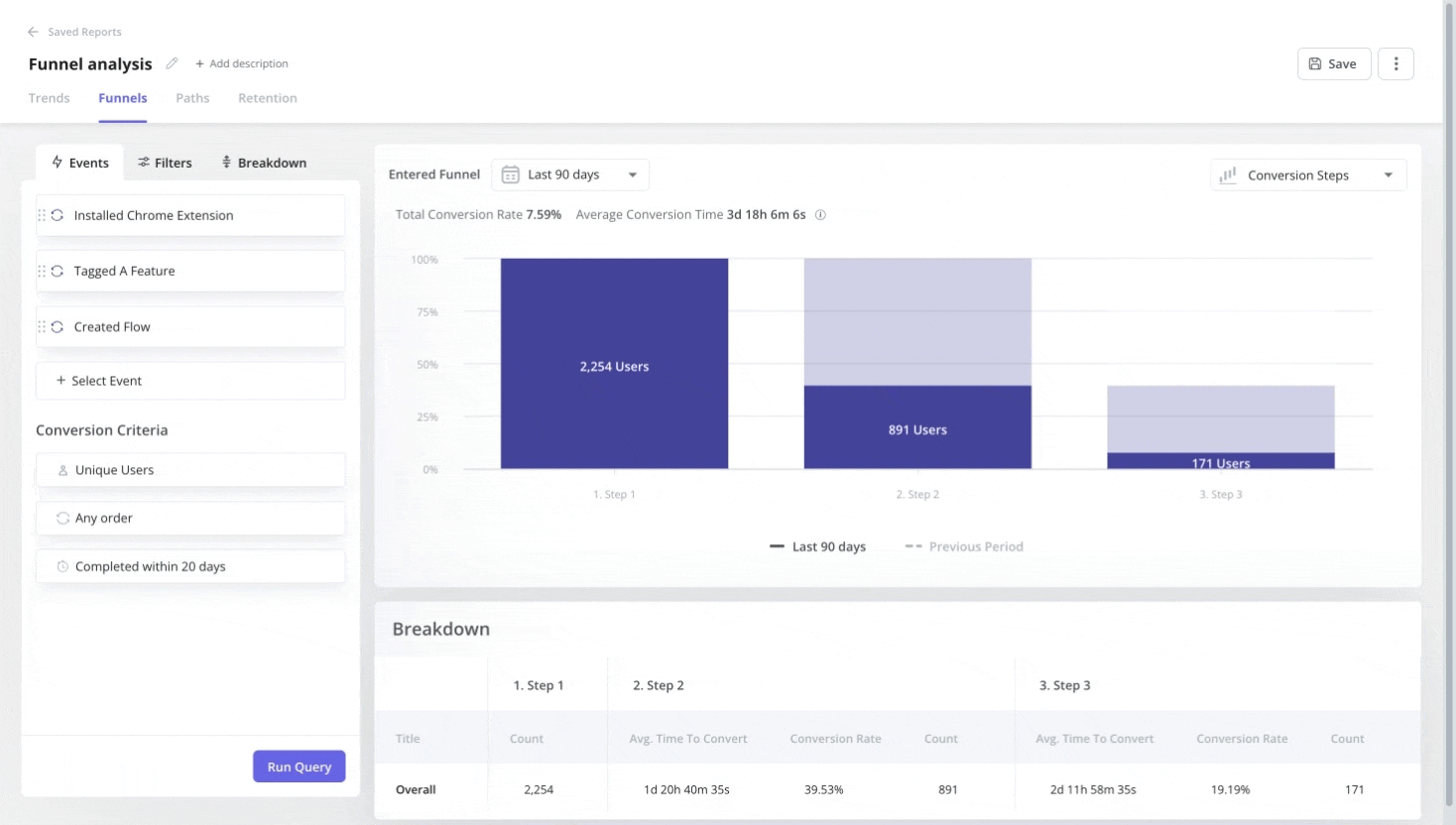
This quantitative foundation helps quantify the business impact of that struggle. If 40% of users drop off at your payment page, and your average order value is $50, you can calculate exactly how much revenue is at stake. That math gets executive attention fast.
Step 2: Uncover the “why” with qualitative insights
Once I know where the problem is, I need to understand why it’s happening. My go-to tool for this is session replay, which lets me watch recordings of real user sessions. I see the rage-clicks, the confused scrolling, and the exact moment of abandonment. These behavioral patterns reveal friction that quantitative data alone can’t capture.
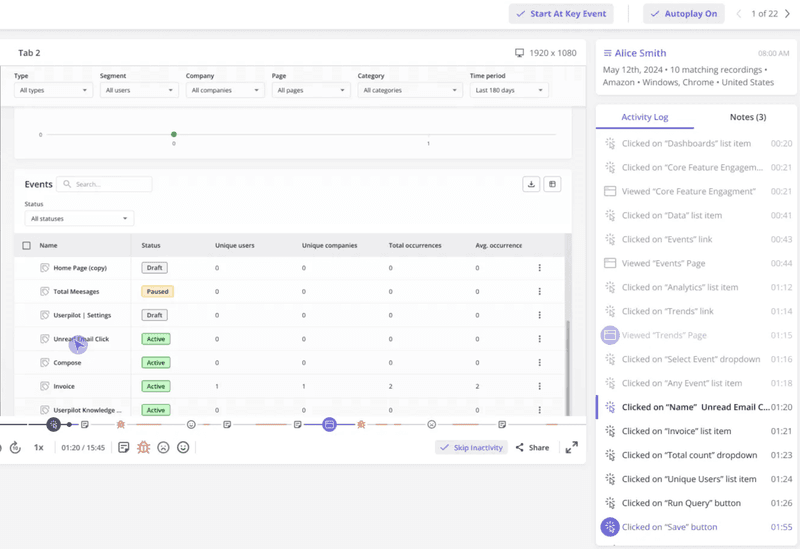
I also deploy targeted in-app surveys at specific friction points to get direct user feedback.
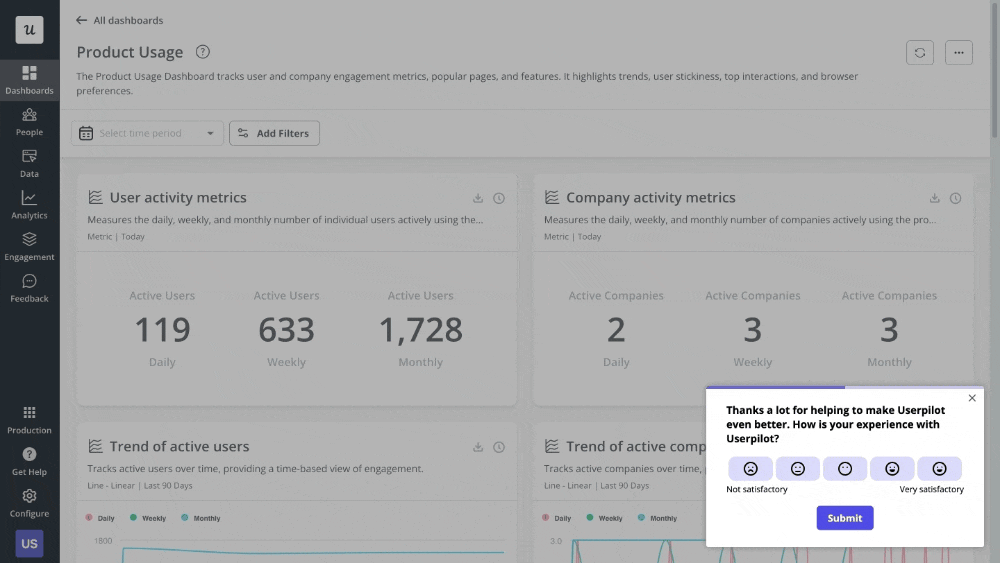
This combination of observation and direct inquiry helps me build strong, evidence-based hypotheses about what’s actually broken.
Step 3: Validate solutions with controlled A/B tests
A strong hypothesis is still an assumption until it’s tested through usability testing. Instead of shipping a fix and hoping it works, I validate proposed solutions with controlled experiments.
Using tools for A/B testing allows me to compare a new design (Variant B) against the original (Control A).
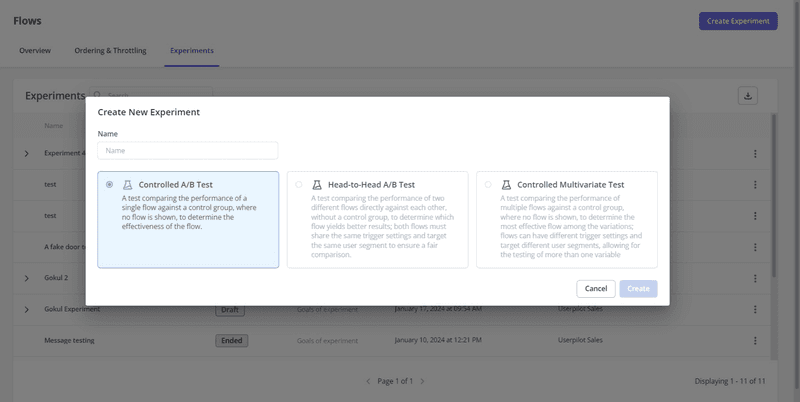
This is where user research transforms into UX testing with measurable business outcomes. This data-driven approach removes ego and opinion from design decisions and proves that my changes have a measurable, positive impact on core UX KPIs.
Step 4: Measure impact and iterate with event tracking
The cycle doesn’t end with a single successful test. I use event tracking to continuously monitor user behavior and measure the long-term impact of changes. With tools like Autocapture, I can automatically collect interaction data on new features without waiting for developers to instrument them.
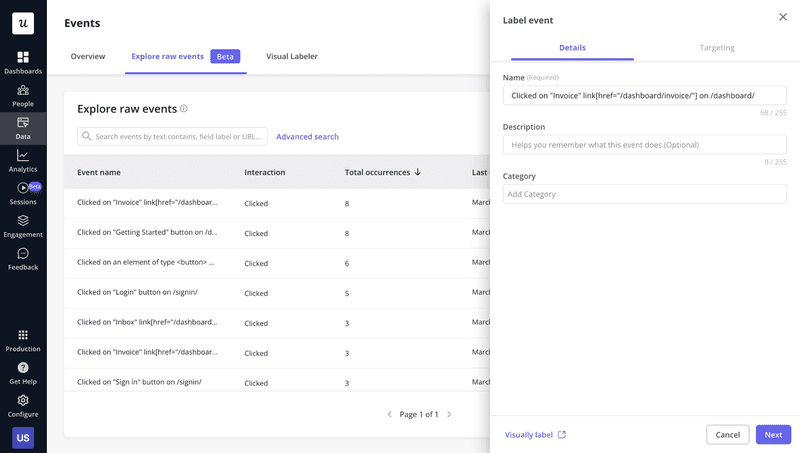
This creates a learning loop. Every change generates new data, which informs the next round of improvements. Customer interactions become a continuous source of UX insights rather than a one-time research project.
Building your data-driven UX case
The powerful UX statistics I’ve shared here can help reframe the entire conversation about the value of design. They prove that positive user experience drives revenue, builds loyalty, and creates sustainable competitive advantage. To get organizational buy-in, you must pair your team’s empathy with this kind of hard data.
If you’re just beginning, start small. Pick one or two key metrics from this article that resonate with your current business challenges. Perhaps the high cost of churn if retention is low, or the 400% conversion lift if growth is the priority. And use the 4-step cycle to connect data to your own product.
Want to get the accurate data required to inform UX improvements? Book a demo with Userpilot. Our all-in-one product growth platform makes it easy to track activation rates, deploy in-app surveys, run A/B tests, and generate actionable reports powered by AI Copilot.
FAQ
UI is the first impression, and it sets the tone for the entire user experience. A well-designed interface makes products feel intuitive and trustworthy, encouraging users to explore features and complete key actions. Poor UI creates confusion and frustration that reduces engagement and satisfaction. Responsive design that works seamlessly across devices is particularly important now, as users expect consistent experiences whether they're on mobile or desktop.
UX directly impacts customer retention by reducing friction, increasing satisfaction, and delivering consistent value throughout the user journey. When users can accomplish their goals quickly and intuitively, they’re more likely to return and continue using your product. That means better customer retention, longer customer lifetimes, and higher revenue.
How does UI impact customer engagement and satisfaction?
UI is the first impression, and it sets the tone for the entire user experience. A well-designed interface makes products feel intuitive and trustworthy, encouraging users to explore features and complete key actions. Poor UI creates confusion and frustration that reduces engagement and satisfaction. Responsive design that works seamlessly across devices is particularly important now, as users expect consistent experiences whether they’re on mobile or desktop.

